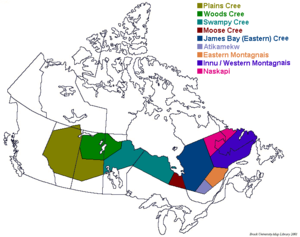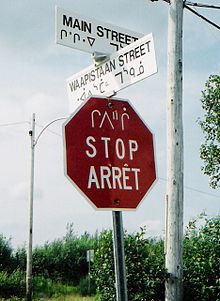- Cree language
-
Cree ᓀᐦᐃᔭᐍᐏᐣ Spoken in Canada, United States Ethnicity Cree Native speakers 117,400 (2006 census)[1]
(including Montagnais–Naskapi and Atikamekw)Language family Algic- Algonquian
- Cree
Writing system Latin, Canadian Aboriginal syllabics (Cree) Official status Regulated by No official regulation Language codes ISO 639-1 cr ISO 639-2 cre ISO 639-3 cre – Macrolanguage
individual codes:
nsk – Naskapi
moe – Montagnais
atj – Atikamekw
crm – Moose Cree
crl – Northern East Cree
crj – Southern East Cree
crw – Swampy Cree
cwd – Woods Cree
crk – Plains Cree A rough map of Cree dialect areas
A rough map of Cree dialect areasThis page contains IPA phonetic symbols in Unicode. Without proper rendering support, you may see question marks, boxes, or other symbols instead of Unicode characters. Cree (Nēhiyawēwin / ᓀᐦᐃᔭᐍᐏᐣ; also known as Cree–Montagnais, Cree–Montagnais–Naskapi) is an Algonquian language spoken by approximately 117,000 people across Canada, from the Northwest Territories and Alberta to Labrador, making it the aboriginal language with the highest number of speakers in Canada.[1] It is also spoken in the U.S. state of Montana. Despite numerous speakers within this wide-ranging area, the only region where Cree has any official status is in the Northwest Territories, alongside eight other aboriginal languages.[2]
Contents
Names
Endonyms are Nēhiyawēwin ᓀᐦᐃᔭᐍᐏᐣ (Plains Cree), Nīhithawīwin (Woods Cree), Nēhinawēwin and Nehirâmowin (Atikamekw), Nehilawewin (Western Montagnais, Piyekwâkamî dialect), Leluwewn (Western Montagnais, Betsiamites dialect), Innu-Aimûn (Eastern Montagnais), Iynu-Ayamûn (Southern Inland East Cree), Iyiyiw-Iyimiwin (Northern East Cree).
Dialect criteria
The Cree dialect continuum can be divided by many criteria. Dialects spoken in northern Ontario and the southern James Bay, Lanaudière, and Mauricie regions of Quebec make a distinct difference between /ʃ/ (sh as in she) and /s/, while those to the west (where both are pronounced /s/) and east (where both are pronounced either /ʃ/ or /h/) do not. In several dialects, including northern Plains Cree and Woods Cree, the long vowels /eː/ and /iː/ have merged into a single vowel, /iː/. In the Québec communities of Chisasibi, Whapmagoostui, and Kawawachikamach, the long vowel /eː/ has merged with /aː/.
However, the most transparent phonological variation between different Cree dialects are the reflexes of Proto-Algonquian *r in the modern dialects, as shown below:
Dialect Location Reflex
of *nWord for "Native person"
← *elenyiwaWord for "You"
← *kīlaPlains Cree SK, AB, BC, NT y iyiniw kiya Woods Cree MB, SK ð/th iðiniw/ithiniw kīða/kītha Swampy Cree ON, MB, SK n ininiw kīna Moose Cree ON l ililiw kīla Northern East Cree QC y īyiyū čīy ᒌ Southern East Cree QC y iynū čīy ᒌ Kawawachikamach Naskapi QC y iyyū čīy Atikamekw QC r iriniw kīr Western Innu QC l ilnū čīl Eastern Innu QC, NL n innū čīn The Plains Cree, speakers of the y dialect, refer to their language as nēhiyawēwin, whereas Woods Cree speakers say nīhithawīwin, and Swampy Cree speakers say nēhinawēwin. This is similar to the alternation in the Siouan languages Dakota, Nakota, and Lakota.
Another important phonological variation among the Cree dialects involves the palatalisation of Proto-Algonquian *k: East of the Ontario-Quebec border (except for Atikamekw), Proto-Algonquian *k has changed into /tʃ/ or /ts/ (ch as in cheese and ts as in Watson) before front vowels. See the table above for examples in the *kīla column.
Very often the Cree dialect continuum is divided into two languages: Cree and Montagnais. Cree includes all dialects which have not undergone the *k -> /tʃ/ sound change (BC–QC) while Montagnais encompasses the territory where this sound change has occurred (QC–NL). These labels are very useful from a linguistic perspective but are confusing as East Cree then qualifies as Montagnais. For practical purposes, Cree usually covers the dialects which use syllabics as their orthography (including Atikamekw but excluding Kawawachikamach Naskapi), the term Montagais then applies to those dialects using the Latin script (excluding Atikamekw and including Kawawachikamach Naskapi). The term Naskapi typically refers to Kawawachikamach (y-dialect) and Natuashish (n-dialect).
Dialect groups
The Cree dialects can be broadly classified into nine groups. From west to east:
ISO-3 ISO-3 name Linguasphere Linguasphere name dialect type additional comments cre Cree (generic) 62-ADA-a Cree cwd Woods Cree
(Nīhithawīwin)62-ADA-ab Woods Cree th / k / s / ī Also known as "Woods/Rocky Cree". In this dialect ē has merged into ī. crk Plains Cree 62-ADA-aa Plains Cree y / k / s / ī (northern)
y / k / s / e (southern)Divided to Southern Plains Cree (Nēhiyawēwin) and Northern Plains Cree (Nēhiyawēmowin). In the Northern dialect, ē has merged into ī. crw Swampy Cree
(Nēhinawēwin)62-ADA-ac Swampy Cree, West
(Ininīmowin)n / k / s / e (western)
n / k / s\š / e (eastern)Also known as "West Main Cree." In the western dialect, š has merged with s. 62-ADA-ad Swampy Cree, East (Ininiwi-Išikišwēwin) crm Moose Cree
(Ililīmowin)62-ADA-ae Moose Cree l / k / s\š / e Also known as "West Main Cree." "Central Main Cree," "West Shore Cree," or "York Cree." crl Northern East Cree
(Īyiyū Ayimūn)62-ADA-af Cree, East y / č / s\š / ā (northern)
y / č / s\š / e (southern-coastal)
y / č / š~s / e (southern-inland)Also known as "James Bay Cree" or "East Main Cree". The long vowels ē and ā have merged in the northern dialect but are distinct in the southern. Southern East Cree is divided between coastal (southwestern) and inland (southeastern) varieties. Also, the inland southern dialect has lost the distinction between s and š. Here, the inland southern dialect falls in line with the rest of the Naskapi groups where both phonemes have become š. Nonetheless, the people from the two areas easily communicate. crj Southern East Cree
(Īnū Ayimūn)62-ADA-ag Cree, Southeast 62-ADA-b Innu nsk Naskapi 62-ADA-ba Mushau Innuts 62-ADA-baa Koksoak y / č / š~s / ā Western Naskapi (Kawawachikamach) 62-ADA-bab Davis Inlet n / č / š~s / ā Eastern Naskapi (Mushuau Innu or Natuashish) moe Montagnais 62-ADA-bb Uashau Innuts + Bersimis 62-ADA-bbe Pointe Bleue l / č / s\š / e Western Montagnais (Leluwewn); also known as the "Betsiamites dialect" 62-ADA-bbd Escoumains 62-ADA-bbc Bersimis 62-ADA-bbb Uashaui Innuts n / č / s\š / e Western Montagnais (Nehilawewin), but sometimes called "Central Montagnais" or "Piyekwâkamî dialect" 62-ADA-bba Mingan n / č / s\š / e Eastern Montagnais (Innu-aimûn) 62-ADA-c Atikamekw atj Atikamekw
(Nehirâmowin)62-ADA-ca Manawan r / k / s\š / e 62-ADA-cb Wemotaci 62-ADA-cc Opitciwan Phonology
This table is made to show all possible consonant phonemes that may be included in a Cree language.
Consonant phonemes Bilabial Dental Alveolar Post-
alveolarPalatal Velar Glottal Nasal m n Stop p t t͡s t͡ʃ k Fricative ð s ʃ h Approximant ɹ j w Lateral l Syntax
Like many Native American languages, Cree features a complex polysynthetic morphology and syntax. A Cree word can be very long, and express something that takes a series of words in English. For example, the Plains Cree word for "school" is kiskinohamātowikamikw, "know.CAUS.APPLICATIVE.RECIPROCAL.place" or the "knowing-it-together-by-example place".
Written Cree
Cree dialects, except for those spoken in eastern Quebec and Labrador, are traditionally written using Cree syllabics, a variant of Canadian Aboriginal syllabics, but can be written with the Roman alphabet as well. The easternmost dialects are written using the Roman alphabet exclusively. Cree dialects for the James Bay Cree are written using Cree syllabics.
Various Cree dialects have begun creating dictionaries to serve their communities. Some projects, such as the Cree Language Resource Project (CLRP) is developing an online bilingual Cree dictionary for the Cree language.
Contact languages
Cree was also a component language in two contact languages unique to Western Canada. Michif is a mixed language combining Cree and French. Bungee is a dialect of English with substrate influences from Cree and Scottish Gaelic. Both languages were spoken by Métis voyageurs and settlers in Western Canada. Michif is still spoken in central Canada and in North Dakota. Many Cree words also became the basis for words in the Chinook Jargon trade language used until some point after contact with Europeans.[citation needed]
Legal status
The social and legal status of Cree varies across Canada. Cree is one of the eleven official languages of the Northwest Territories, but is only spoken by a small number of people there in the area around the town of Fort Smith.[2]
In many areas, it is a vibrant community language spoken by large majorities and taught in schools through immersion and second-language programmes. In other areas, its use has declined dramatically. Cree is one of the least endangered aboriginal languages in North America, but is nonetheless at risk since it possesses little institutional support in most areas.
See also
References
- Ahenakew, Freda, Cree Language Structures: A Cree Approach. Pemmican Publications Inc., 1987. ISBN 0-919143-42-3
- Steller, Lea-Katharina (née Virághalmy): Alkalmazkodni és újat adni – avagy „accomodatio“ a paleográfiában In: Paleográfiai kalandozások. Szentendre, 1995. ISBN 963-450-922-3
- Wolfart, H. C. & Freda Ahenakew, The Student's Dictionary of Literary Plains Cree. Memoir 15, Algonquian and Iroquoian Linguistics, 1998. ISBN 0-921064-15-2
- Wolvengrey, Arok, ed. nēhiýawēwin: itwēwina / Cree: Words / ᓀᐦᐃᔭᐍᐏᐣ: ᐃᑗᐏᓇ [includes Latin orthography and Cree syllabics]. [Cree–English English–Cree Dictionary – Volume 1: Cree-English; Volume 2: English-Cree]. Canadian Plains Research Center, 15 October 2001. ISBN 0-88977-127-8
- Bloomfield, Leonard. Plains Cree Texts. New York: AMS Press, 1974. ISBN 0404581668
- Castel, Robert J., and David Westfall. Castel's English–Cree Dictionary and Memoirs of the Elders Based on the Woods Cree of Pukatawagan, Manitoba. Brandon, Man: Brandon University Northern Teacher Education Program, 2001. ISBN 0968985807
- Dahlstrom, Amy. Plains Cree Morphosyntax. Outstanding dissertations in linguistics. New York: Garland Pub, 1991. ISBN 0815301723
- Ellis, C. D. Spoken Cree, Level I, west coast of James Bay. Edmonton: University of Alberta Press, 2000. ISBN 0888643470
- Junker, Marie-Odile, Marguerite MacKenzie, Luci Salt, Alice Duff, Daisy Moar & Ruth Salt (réds) (2007–2008) Le Dictionnaire du cri de l'Est de la Baie James sur la toile: français-cri et cri-français (dialectes du Sud et du Nord).
- LeClaire, Nancy, George Cardinal, Earle H. Waugh, and Emily Hunter. Alberta Elders' Cree Dictionary = Alperta Ohci Kehtehayak Nehiyaw Otwestamakewasinahikan. Edmonton: University of Alberta Press, 1998. ISBN 0888643098
- MacKenzie, Marguerite, Marie-Odile Junker, Luci Salt, Elsie Duff, Daisy Moar, Ruth Salt, Ella Neeposh & Bill Jancewicz (eds) (2004–2008) The Eastern James Bay Cree Dictionary on the Web : English-Cree and Cree-English (Northern and Southern dialect).
- Hirose, Tomio. Origins of predicates evidence from Plains Cree. Outstanding dissertations in linguistics. New York: Routledge, 2003. ISBN 0415967791
- Wolfart, H. Christoph. Plains Cree A Grammatical Study. Transactions of the American Philosophical Society, new ser., v. 63, pt. 5. Philadelphia: American Philosophical Society, 1973. ISBN 0871696355
Notes
- ^ a b Statistics Canada: 2006 Census
- ^ a b Northwest Territories Official Languages Act, 1988 (as amended 1988, 1991–1992, 2003)
External links
- The Cree-Innu linguistic atlas
- The Gift of Language and Culture website
- Nehinawe: Speak Cree
- The East Cree language web
- Cree on-line Spelling Lessons
- The Cree-Innu linguistic atlas
- On-line Eastern James Bay Cree dictionary (covers both Northern and Southern dialects)
- Our Languages: Cree (Saskatchewan Indian Cultural Centre)
- Languagegeek: Cree—OpenType font repository of aboriginal languages (including Cree).
- CBC Digital Archives—Eeyou Istchee: Land of the Cree
- On-line Cree dictionary
- Path of the Elders – Explore Treaty 9, Aboriginal Cree & First Nations history.
 Languages of Quebec
Languages of QuebecFrench (official language)
English · Algonquin · Atikamekw · Abenaki · Cree · Malecite-Passamaquoddy · Míkmaq · Mohawk · Innu-aimun · Inuktitut - Algonquian
Wikimedia Foundation. 2010.

